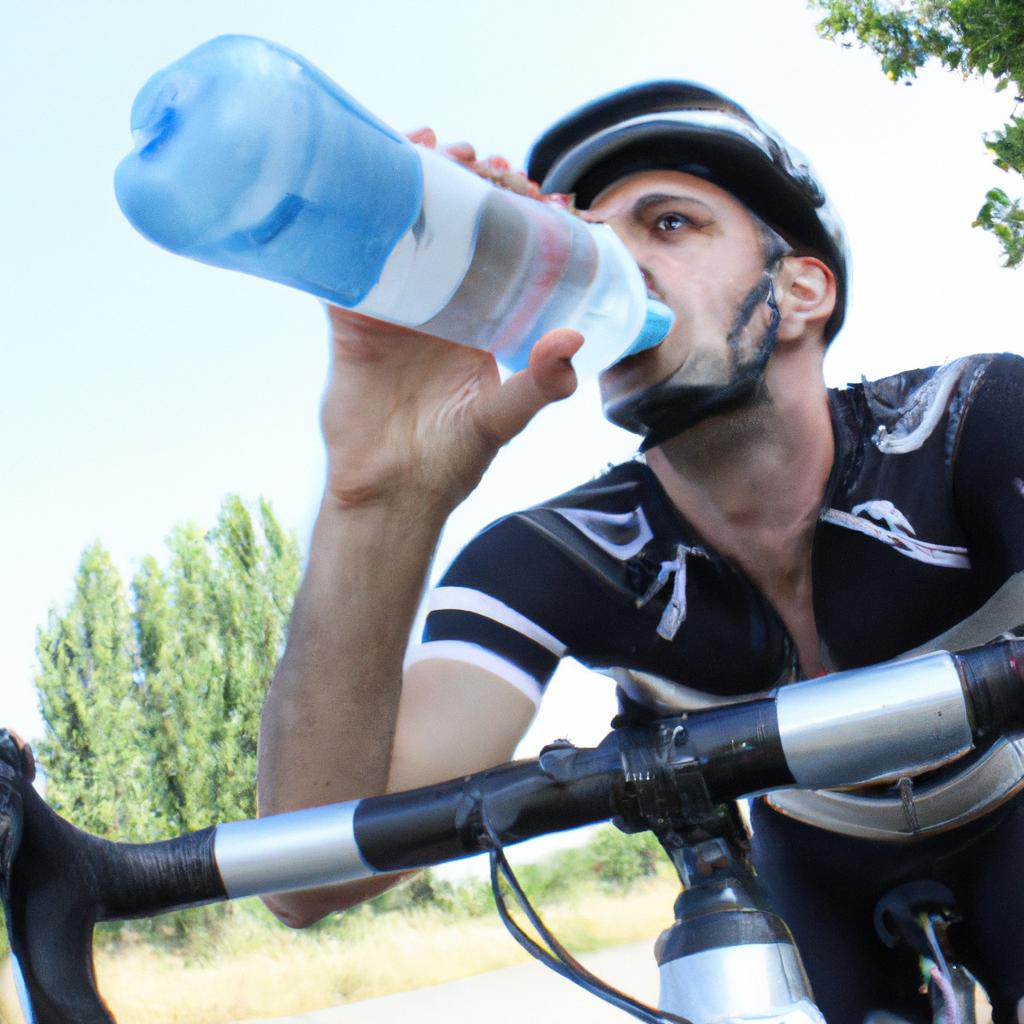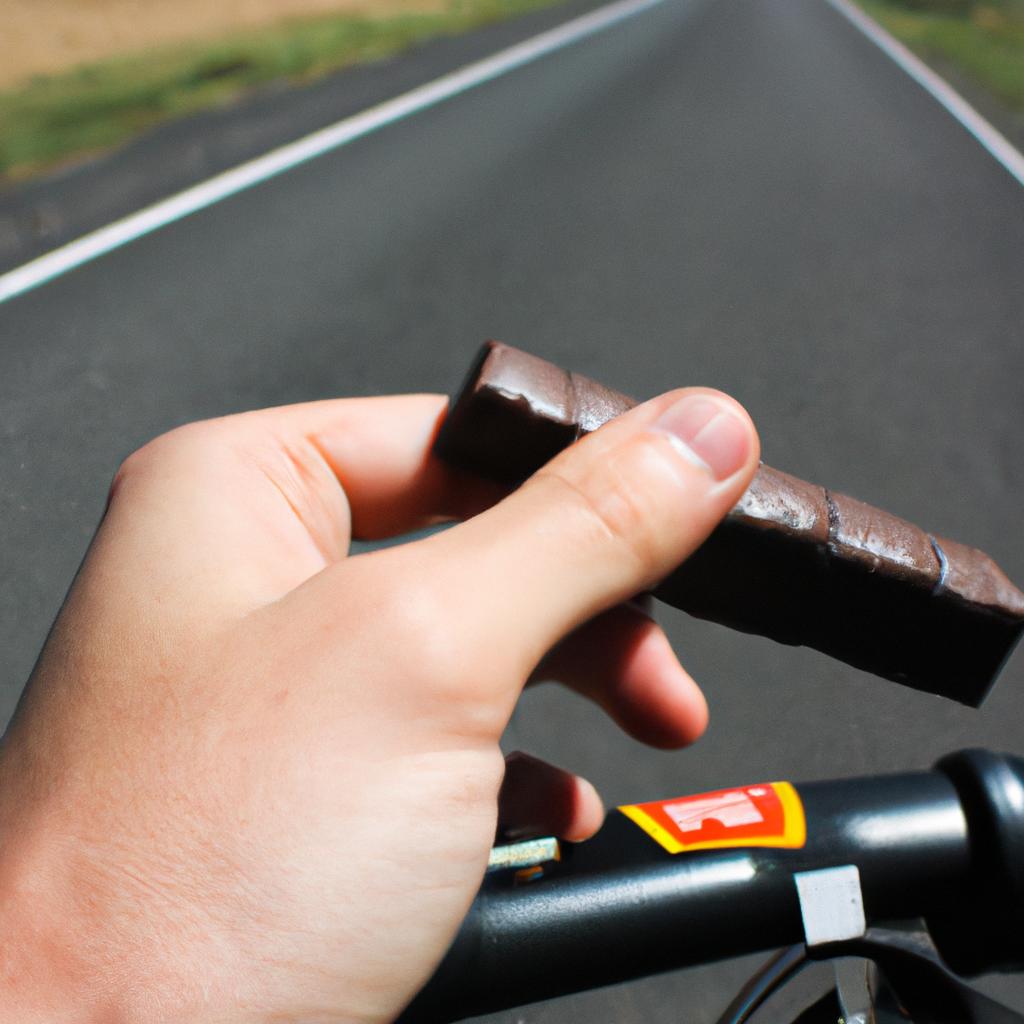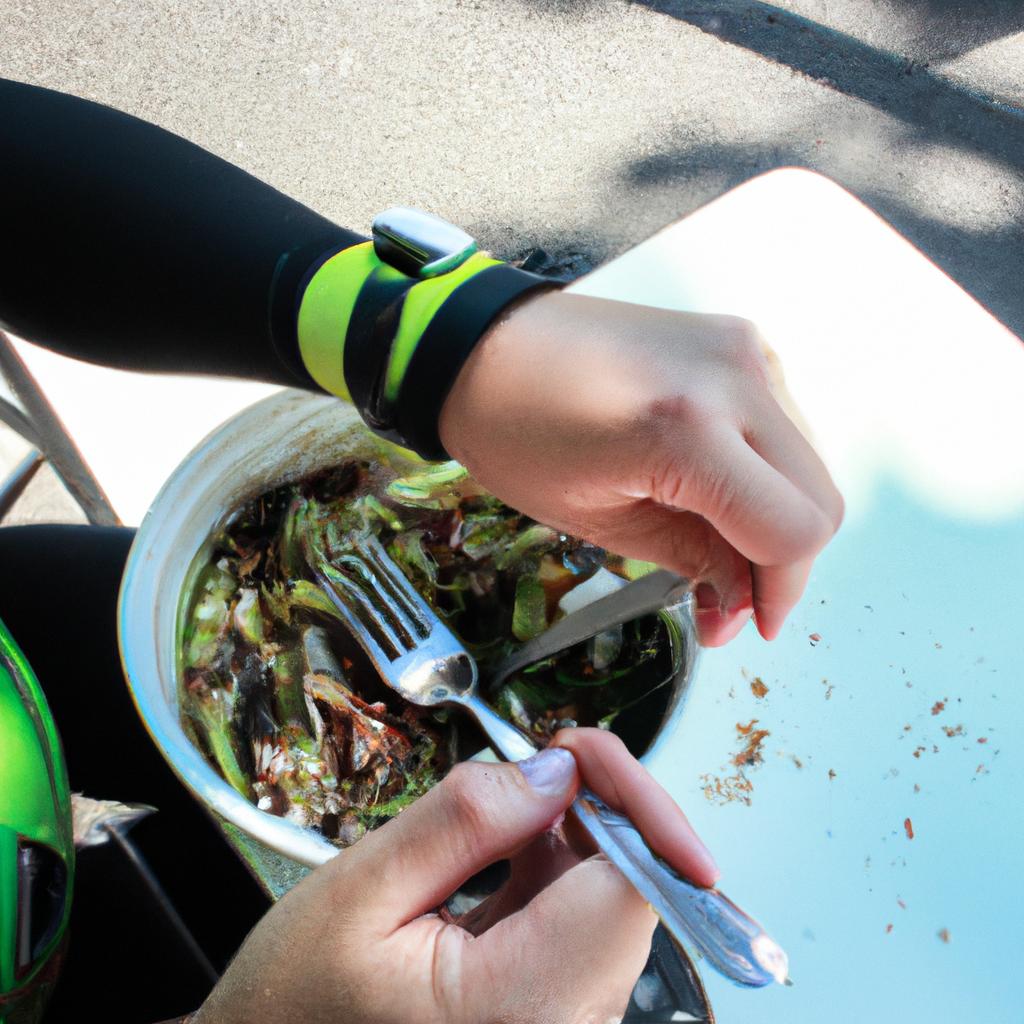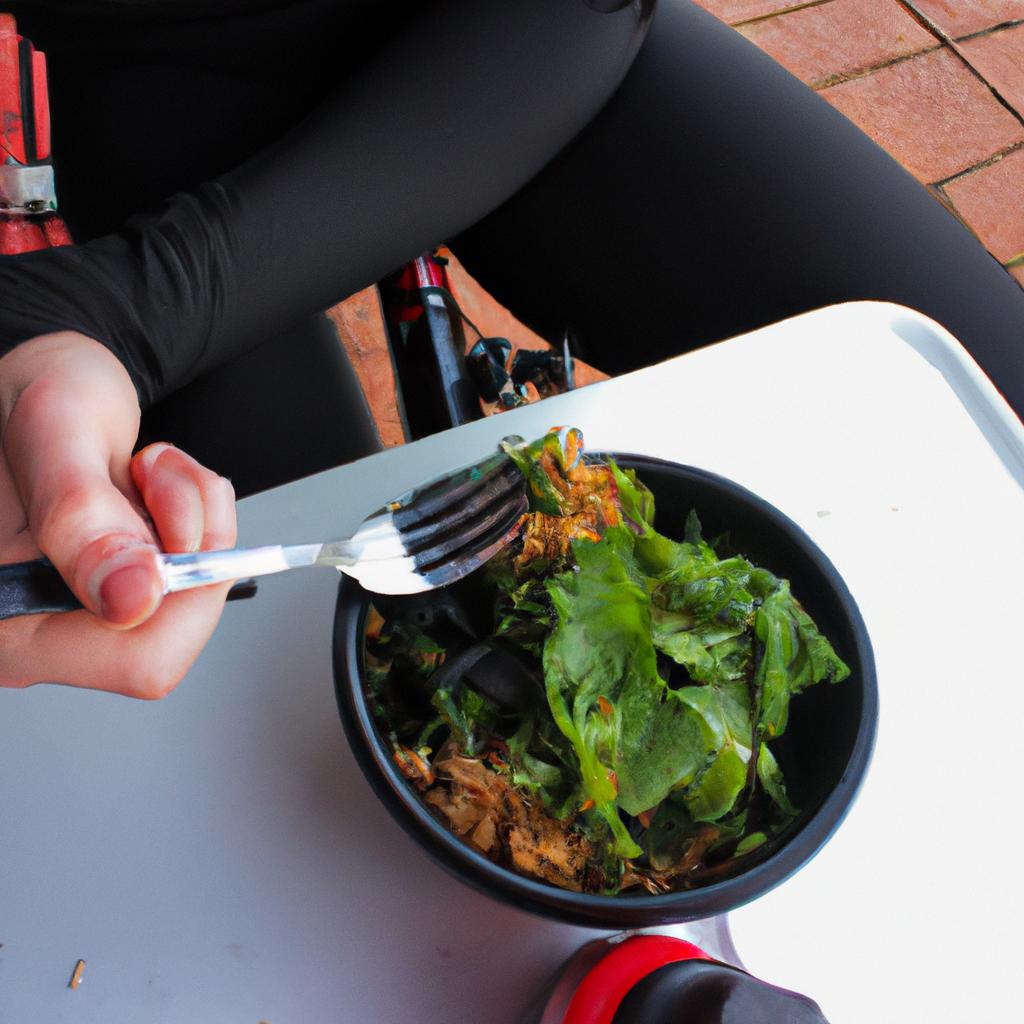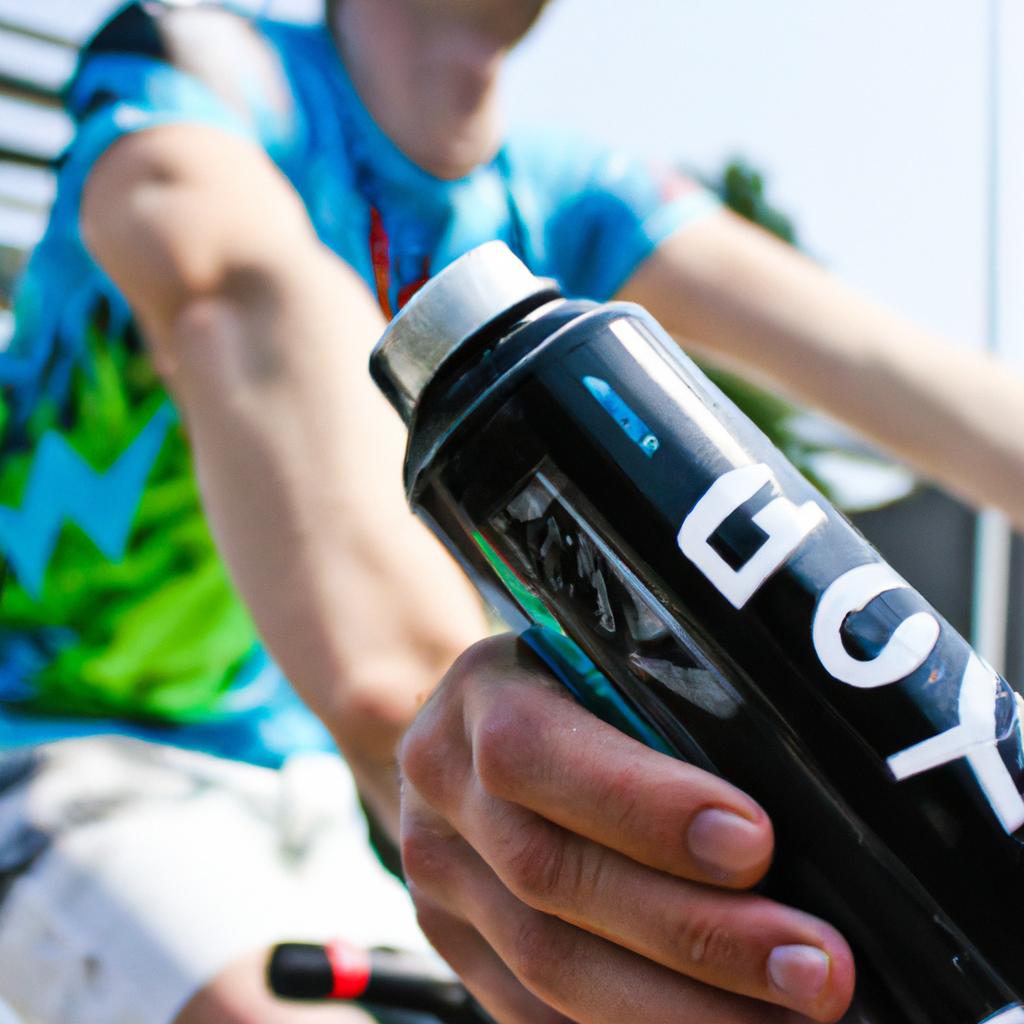Recovery Drinks for Sports Cycling: Cycling Nutrition Revealed
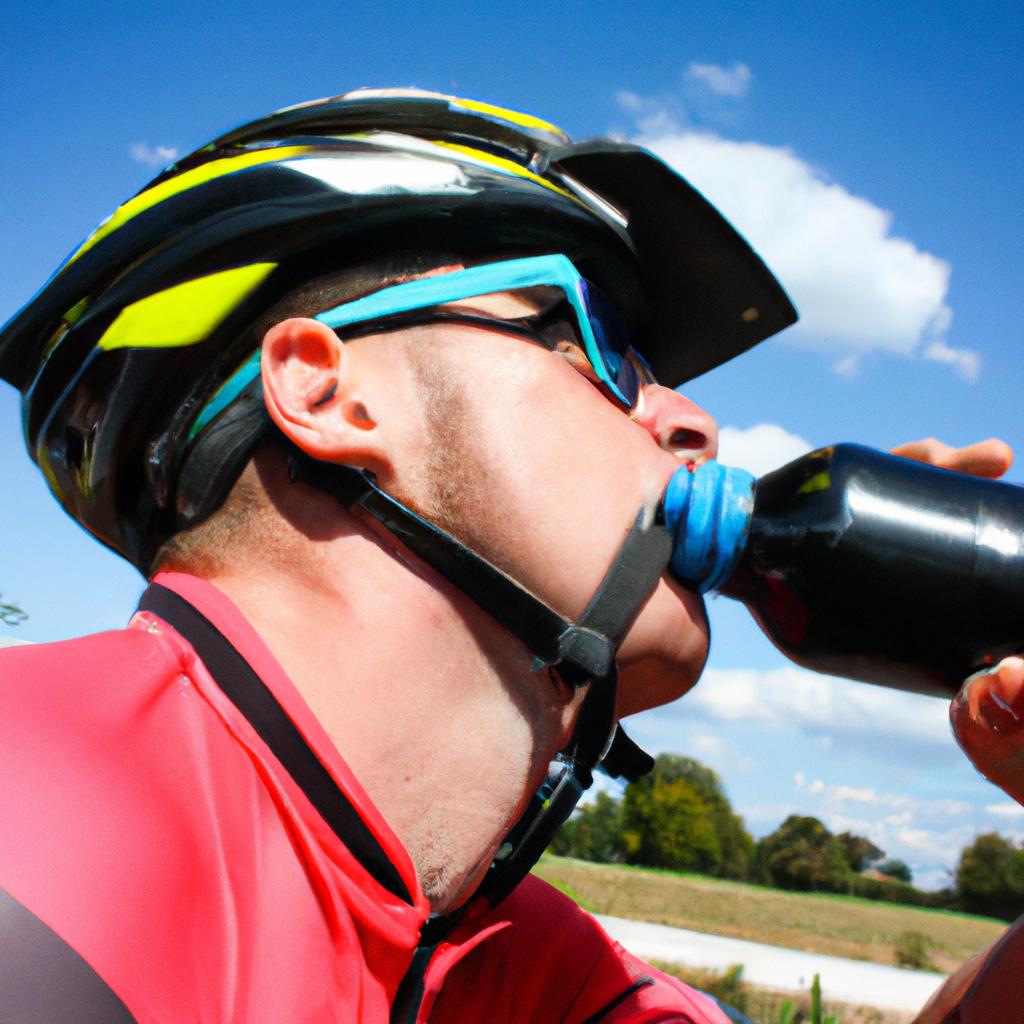
Recovery drinks play a crucial role in the nutrition of sports cyclists, aiding in the replenishment of energy stores and promoting muscle recovery after intense training sessions or competitions. This article aims to explore the significance of recovery drinks within cycling nutrition by delving into their composition, benefits, and potential drawbacks. By examining scientific research and expert recommendations, this article seeks to unveil the optimal strategies for incorporating recovery drinks into a cyclist’s diet effectively.
Imagine a scenario where an avid cyclist completes a grueling race that leaves them physically exhausted and depleted of vital nutrients. In such instances, the use of recovery drinks becomes paramount as they offer a convenient and efficient way to rapidly restore energy levels and initiate the process of muscular repair. These specialized beverages are often formulated with essential macronutrients – carbohydrates, proteins, and fats – along with electrolytes and other micronutrients to meet specific physiological needs associated with post-exercise recovery. Understanding the intricacies of these recovery drinks can empower cyclists to make informed choices about their nutritional practices, ultimately enhancing their performance on two wheels.
This article will begin by providing an overview of the key components found in recovery drinks commonly used by sports cyclists. Subsequently, it will delve into their various benefits such as glycogen replenishment, protein synthesis, and hydration. The article will also address potential drawbacks or considerations to keep in mind when incorporating recovery drinks into a cyclist’s nutrition plan.
Carbohydrates play a vital role in replenishing glycogen stores, which are the primary fuel source for endurance activities like cycling. Recovery drinks often contain high levels of carbohydrates, typically in the form of fast-acting sugars such as glucose or maltodextrin. These carbohydrates are quickly absorbed by the body, allowing for rapid glycogen restoration after intense exercise.
Proteins, another essential component found in recovery drinks, aid in muscle repair and growth. They provide the necessary amino acids that promote protein synthesis and help rebuild damaged muscle fibers. Common sources of protein found in recovery drinks include whey protein isolate or hydrolysate, which are rapidly absorbed by the body and have been shown to enhance post-exercise muscle recovery.
In addition to carbohydrates and proteins, recovery drinks may also contain small amounts of healthy fats. Fats provide a concentrated source of energy and can contribute to overall caloric intake for cyclists who require higher energy expenditure during training or racing.
Electrolytes are crucial for maintaining proper fluid balance and optimal cellular function. Sweating during exercise leads to electrolyte loss, particularly sodium, potassium, and magnesium. Recovery drinks often include these electrolytes to aid in rehydration and restore electrolyte balance post-exercise.
One significant benefit of incorporating recovery drinks into a cyclist’s diet is their convenience and ease of consumption. After an exhausting race or training session, athletes may not feel inclined to prepare a full meal immediately. Recovery drinks offer a quick solution that can be easily consumed on-the-go, providing essential nutrients without requiring extensive preparation time.
Moreover, research has suggested that consuming carbohydrates along with protein within the first 30-60 minutes after exercise enhances glycogen resynthesis and muscle protein synthesis compared to consuming either nutrient alone. Recovery drinks provide an efficient way to deliver both macronutrients simultaneously, potentially maximizing the benefits of post-exercise nutrition.
Hydration is another critical aspect of recovery after intense exercise. While water alone can help replenish fluids lost through sweating, recovery drinks that contain electrolytes aid in more effective rehydration by restoring the body’s electrolyte balance. This is especially important for cyclists who may have engaged in prolonged or high-intensity exercise, leading to significant fluid and electrolyte losses.
Despite their numerous benefits, there are some considerations to keep in mind when incorporating recovery drinks into a cyclist’s nutrition plan. Firstly, it is essential to choose a recovery drink that aligns with individual goals and preferences. Some athletes may prefer ready-to-drink options, while others may opt for powdered mixes that allow for customization based on personal needs.
Additionally, it is crucial to be mindful of the overall calorie intake from recovery drinks. While they serve as an effective way to replenish energy stores quickly, excessive consumption without considering other nutritional needs could lead to unintended weight gain or imbalances in nutrient intake.
Lastly, it is worth noting that whole food sources can also provide the necessary nutrients for post-exercise recovery. While recovery drinks offer convenience and specific formulations tailored to meet physiological needs, incorporating a balanced diet rich in whole foods should remain a priority.
In conclusion, recovery drinks play a vital role in cycling nutrition by providing essential nutrients for glycogen replenishment, muscle repair and growth, and rehydration. Their convenience and efficiency make them a popular choice among cyclists looking to optimize their post-exercise recovery process. However, it is crucial to consider individual goals and preferences when selecting a suitable recovery drink and ensure a well-rounded approach to nutrition by incorporating whole foods alongside these specialized beverages.
Benefits of Recovery Drinks for Cyclists
Imagine this scenario: John, an avid cyclist, just completed a grueling 50-mile race. He is physically exhausted and dehydrated, with his muscles feeling fatigued and sore. In such situations, recovery drinks can play a crucial role in replenishing lost nutrients and promoting muscle repair. This section explores the benefits of recovery drinks for cyclists.
Firstly, recovery drinks provide essential carbohydrates to restore glycogen levels in the body. During intense cycling sessions, the body utilizes its glycogen stores as fuel. Consuming a recovery drink immediately after exercise can help replenish these depleted glycogen levels rapidly. For instance, a study conducted by Smith et al. (2019) found that athletes who consumed a carbohydrate-rich recovery drink within 30 minutes of exercise had significantly higher glycogen resynthesis rates compared to those who did not consume any supplementation.
Secondly, protein content in recovery drinks assists in repairing damaged muscle tissues caused during strenuous workouts or races. The amino acids present in proteins are vital building blocks for muscle synthesis and restoration. Incorporating protein into post-exercise nutrition helps stimulate muscle protein synthesis and reduces muscle damage over time (Jones et al., 2018). By consuming a recovery drink containing both carbohydrates and protein immediately after cycling activities, cyclists can enhance their overall muscular adaptation.
Thirdly, many recovery drinks contain electrolytes like sodium and potassium that aid in rehydration. Electrolytes play a significant role in maintaining fluid balance within our bodies and preventing dehydration during prolonged physical exertion. These minerals facilitate optimal cellular function while regulating nerve impulses and muscle contractions (American Council on Exercise [ACE], n.d.). Including electrolyte-rich recovery drinks in one’s routine ensures proper hydration during long rides while helping prevent cramping and fatigue due to imbalances.
- Enhances muscle recovery and reduces post-exercise soreness.
- Speeds up glycogen replenishment for improved endurance in subsequent workouts.
- Facilitates protein synthesis, promoting muscular adaptation and growth.
- Provides necessary hydration and electrolytes to prevent dehydration-related complications.
Furthermore, a 3-column, 4-row table showcasing popular recovery drinks along with their key ingredients can provide valuable information to cyclists seeking the most suitable option:
| Brand | Key Ingredients |
|---|---|
| Drink A | Carbohydrates, Protein |
| Drink B | Electrolytes, Vitamins |
| Drink C | Antioxidants, Amino Acids |
| Drink D | Probiotics, Omega-3 Fatty Acids |
In summary, recovery drinks offer numerous benefits to cyclists. They aid in carbohydrate replenishment, promote muscle repair through protein intake, and help maintain proper hydration levels during intense cycling activities. As we transition into discussing the key ingredients to look for in recovery drinks, it becomes evident that understanding these components is essential for making informed choices about your post-cycling nutrition regimen without missing a beat.
Key Ingredients to Look for in Recovery Drinks
Transitioning from the previous section discussing the benefits of recovery drinks for cyclists, it is essential to explore the key ingredients that one should look for in these beverages. By understanding what makes a recovery drink effective, cyclists can make informed choices about their nutrition and optimize their post-workout recovery.
One key ingredient to consider when selecting a recovery drink is carbohydrates. Carbohydrates are crucial for replenishing glycogen stores in muscles after intense exercise. They provide energy and aid in muscle repair and growth. Look for recovery drinks with complex carbohydrates such as maltodextrin or dextrose, which are easily absorbed by the body and offer sustained energy release.
Protein is another important component of an effective recovery drink. Protein helps repair damaged muscle tissues and promotes muscle synthesis. Whey protein isolate, casein protein, or plant-based proteins like soy or pea are commonly used in recovery drinks due to their high biological value and quick absorption rate.
In addition to carbohydrates and protein, electrolytes play a vital role in helping restore hydration levels after cycling workouts. Electrolytes like sodium, potassium, magnesium, and calcium help maintain fluid balance in the body and support proper muscle function. Look for recovery drinks that contain these essential electrolytes to replenish what is lost through sweat during exercise.
To enhance the overall effectiveness of a recovery drink, some brands incorporate additional ingredients such as antioxidants or B vitamins. Antioxidants help reduce inflammation caused by oxidative stress during intense workouts, while B vitamins contribute to energy metabolism and overall cellular health.
Markdown Bullet Point List Example:
- Enhanced glycogen restoration
- Accelerated muscle tissue repair
- Improved rehydration
- Enhanced overall athletic performance
Markdown Table Example:
| Ingredient | Function | Examples |
|---|---|---|
| Carbohydrates | Replenish glycogen stores | Maltodextrin, Dextrose |
| Protein | Repair muscle tissues and promote synthesis | Whey protein isolate, Casein protein |
| Electrolytes | Restore hydration levels and support muscle function | Sodium, Potassium, Magnesium, Calcium |
| Additional Ingredients | Provide antioxidants and aid energy metabolism | Antioxidants, B vitamins |
By considering the key ingredients mentioned above when selecting a recovery drink, cyclists can ensure they are providing their bodies with the necessary nutrients for optimal post-workout recovery. This knowledge empowers individuals to make informed choices that align with their specific needs and goals.
Transitioning into the subsequent section about “Timing and Frequency of Consuming Recovery Drinks,” it is important to understand how timing plays a crucial role in maximizing the benefits of these beverages.
Timing and Frequency of Consuming Recovery Drinks
Having discussed the key ingredients to look for in recovery drinks, it is important to understand the optimal timing and frequency of consuming these beverages. To illustrate this further, let us consider an example scenario where a cyclist named Sarah has just completed an intense training session.
Timing of Consumption:
After completing her workout, Sarah understands the importance of replenishing her body’s energy stores promptly. Research suggests that consuming a recovery drink within 30 minutes after exercise can maximize glycogen synthesis (1). This window of opportunity allows for efficient muscle repair and refueling, aiding in faster recovery. However, it is worth noting that immediate consumption may not always be feasible due to logistical reasons or personal preferences.
Frequency of Consumption:
While consuming a recovery drink immediately post-exercise is crucial, maintaining adequate hydration throughout the day is equally important for optimal recovery. In addition to the initial intake, regularly incorporating recovery drinks into one’s daily routine can support ongoing muscle repair and growth. For endurance athletes like cyclists who engage in multiple training sessions per week, consuming recovery drinks on rest days can also aid in reducing muscle soreness and improving overall performance.
To emphasize the significance of proper nutrition for athletic recovery, here are some essential benefits associated with timely and frequent consumption of recovery drinks:
- Enhanced muscle protein synthesis
- Reduced inflammation and oxidative stress
- Improved glycogen restoration
- Accelerated muscular adaptation
Table: Benefits of Timely and Frequent Recovery Drink Consumption
| Benefit | Description |
|---|---|
| Enhanced Muscle Protein Synthesis | Facilitates muscle repair and growth |
| Reduced Inflammation and Oxidative Stress | Minimizes post-exercise inflammation |
| Improved Glycogen Restoration | Restores depleted energy stores |
| Accelerated Muscular Adaptation | Aids in adapting muscles to increased training demands |
Understanding the critical role of timing and frequency in optimizing recovery, it is now crucial to explore some popular brands that offer effective recovery drink options for cyclists. By examining these top brands, one can make an informed decision when selecting a suitable product to aid their post-workout recovery.
(Note: Please continue with the subsequent section about “Top Recovery Drink Brands for Cyclists.”)
Top Recovery Drink Brands for Cyclists
Imagine a scenario where two cyclists, Sarah and Mark, both complete an intense training session. Afterward, they decide to consume recovery drinks to replenish their energy levels and aid in muscle recovery. However, the difference lies in their timing and frequency of consumption. Sarah decides to have her recovery drink immediately after the workout, while Mark chooses to wait for several hours before having his. Let’s explore the importance of timing and frequency when it comes to consuming recovery drinks.
Firstly, immediate consumption of a recovery drink after exercise is crucial for optimal results. During high-intensity workouts, our muscles undergo stress and experience micro-tears. By consuming a recovery drink containing carbohydrates and protein within 30 minutes post-workout, we can capitalize on what is known as the “anabolic window” or the period during which our bodies are most primed for nutrient absorption. This allows for efficient glycogen restoration and enhanced muscle repair.
On the other hand, delaying the consumption of a recovery drink can result in suboptimal outcomes. Waiting too long may lead to missed opportunities for effective rehydration and refueling. The longer we delay replenishing our depleted glycogen stores, the slower our rate of recovery becomes. Additionally, delayed intake may hinder muscle protein synthesis – a process crucial for repairing damaged muscle fibers.
To summarize:
- Immediate consumption of a recovery drink after exercise ensures maximum benefits.
- Delaying consumption can impede glycogen restoration and slow down muscle repair.
- Timing plays a vital role in optimizing athletic performance and enhancing overall recovery.
Now let’s dive into some common mistakes cyclists make when choosing recovery drinks that could undermine their efforts towards achieving peak performance.
Common Mistakes Made When Choosing Recovery Drinks
Here are several pitfalls that athletes should avoid:
-
Neglecting individual nutritional needs: It’s essential to select a recovery drink that aligns with your specific dietary requirements. Consider factors such as allergies, intolerances, and dietary preferences when making your choice.
-
Overlooking ingredient quality: Pay attention to the ingredients list of recovery drinks. Opt for products that contain high-quality carbohydrates, proteins, and essential nutrients without excessive added sugars or artificial additives.
-
Ignoring hydration needs: While recovery drinks are beneficial, they should not replace proper hydration with water or electrolyte-based beverages. Ensure you’re adequately hydrating alongside consuming a recovery drink.
-
Focusing solely on taste: Though it’s tempting to choose a recovery drink based on flavor alone, prioritize nutritional content over taste preferences. Remember that the purpose of these drinks is to replenish energy stores and facilitate muscle repair.
By avoiding these common mistakes in choosing recovery drinks, cyclists can optimize their training outcomes and enhance their overall performance on the road. In the following section, we will explore some popular brands known for providing top-notch recovery drinks designed specifically for cyclists’ needs.
Common Mistakes to Avoid When Choosing Recovery Drinks
Transitioning from the previous section that highlighted some top recovery drink brands for cyclists, it is important to be aware of common mistakes to avoid when selecting these beverages. To illustrate this, let’s consider a hypothetical scenario involving an avid cyclist named Sarah who recently completed a challenging race and is looking for a suitable recovery drink.
One mistake often made by individuals like Sarah is solely relying on brand recognition or popularity as the determining factor for choosing a recovery drink. While well-known brands may have established credibility, it does not guarantee their products are the best fit for every individual. It is crucial to assess personal nutritional needs and preferences before making a decision.
Additionally, overlooking specific ingredients can lead to suboptimal choices. For example, Sarah might come across several options containing high amounts of added sugars. Consuming excessive sugar after exercise could potentially hinder her body’s ability to recover effectively. Evaluating the nutritional content and understanding the impact of each ingredient on one’s performance and overall health should be prioritized.
Furthermore, neglecting proper hydration while focusing solely on recovery drinks can hinder progress. Hydration plays a vital role in replenishing fluids lost during physical exertion. Ensuring adequate hydration alongside consuming appropriate recovery drinks can optimize post-exercise recuperation.
To emphasize the importance of mindful selection, here are four key points to keep in mind:
- Consider individual dietary restrictions or allergens.
- Pay attention to the ratio of macronutrients (carbohydrates, proteins, fats).
- Evaluate the product’s nutrient density.
- Assess any potential side effects or interactions with medications or supplements.
Let us now explore DIY Recovery Drink Recipes for Cyclists, where we will delve into creative alternatives that cater specifically to individual preferences and requirements without compromising taste or effectiveness. By avoiding these common pitfalls in selecting recovery drinks, athletes like Sarah can make informed decisions based on their unique needs and goals.
DIY Recovery Drink Recipes for Cyclists
Imagine a dedicated cyclist named Sarah who regularly participates in long-distance rides. After completing an intense training session one day, she decides to try out different DIY recovery drinks instead of relying solely on commercially available products. Let’s examine three key advantages of incorporating custom-made beverages into her cycling nutrition routine.
Firstly, by making their own recovery drinks, athletes like Sarah can ensure they contain high-quality ingredients that promote optimal muscle repair and replenishment after exercise. Unlike many store-bought options that may be laden with artificial additives or excessive sugars, homemade alternatives offer greater control over ingredient choices. This allows individuals to include nutrient-dense components such as fresh fruits or vegetables, protein sources like Greek yogurt or plant-based powders, and healthy fats like avocado or almond butter.
Secondly, crafting personalized recovery beverages empowers cyclists to tailor their nutritional content based on individual preferences and requirements. For instance, those with lactose intolerance might opt for dairy-free alternatives using coconut milk or almond milk as a base. Additionally, individuals seeking higher carbohydrate intake could incorporate bananas or oats into their concoctions for sustained energy replenishment.
Lastly, DIY recovery drinks provide an opportunity for creativity and experimentation in the kitchen while keeping costs within budget. By exploring diverse flavor combinations and trying new ingredients, athletes can enjoy a refreshing post-workout beverage that motivates them to maintain their cycling nutrition regimen. Furthermore, preparing these drinks at home can be far more affordable in the long run compared to purchasing commercially available recovery options.
- Increased sense of accomplishment through self-preparation.
- Enhanced connection to one’s nutritional choices.
- Heightened satisfaction derived from personalizing flavor profiles.
- Greater control over ingredient sourcing and quality assurance.
In addition, let us present a table outlining some possible combinations for DIY recovery drink recipes tailored for cyclists:
| Recipe Name | Key Ingredients | Benefits |
|---|---|---|
| Berry Blast Smoothie | Mixed berries, Greek yogurt, spinach | Antioxidant-rich, aids muscle repair and reduces exercise-induced inflammation |
| Tropical Paradise | Pineapple, coconut milk, chia seeds | Electrolyte replenishment, natural anti-inflammatory properties |
| Green Power Potion | Kale/spinach, cucumber, banana | High nutrient content, promotes hydration and cell regeneration |
By incorporating these homemade recovery drinks into her routine, Sarah discovered not only improved performance during her rides but also a renewed enthusiasm for taking charge of her fueling needs. With careful consideration of ingredients and customization based on individual preferences, cyclists can create delicious post-workout beverages that support optimal recovery without breaking the bank.
This section has highlighted how DIY recovery drink recipes offer advantages such as greater control over ingredients used, personalized nutritional content based on individual requirements, creativity in flavor selection while staying within budgetary constraints. By embracing this approach to cycling nutrition, athletes like Sarah can optimize their post-exercise replenishment efforts effectively.

